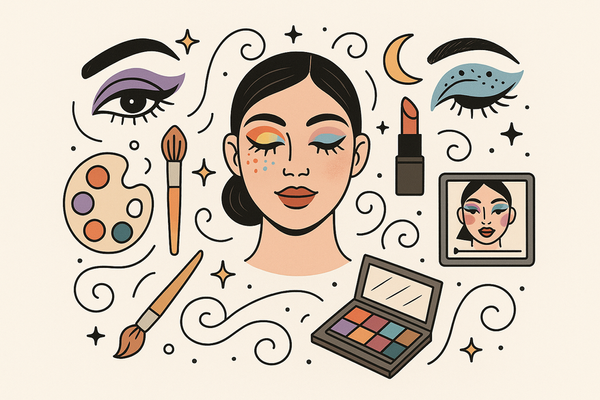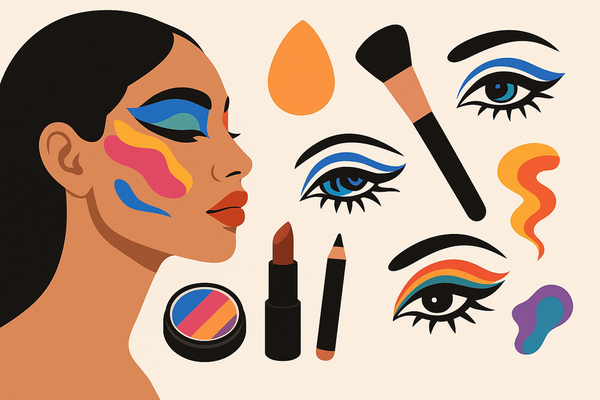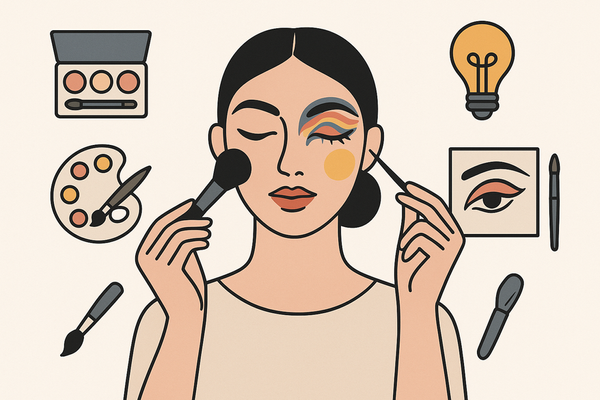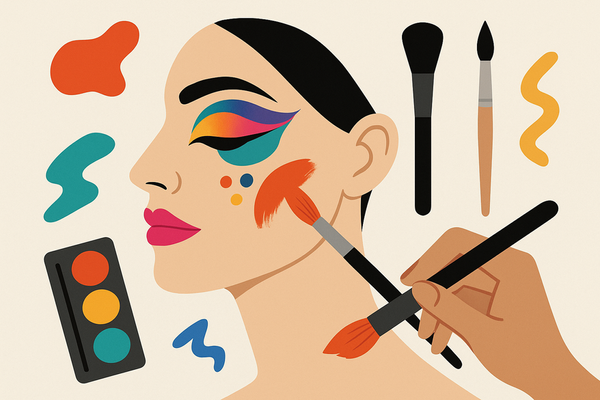The Ultimate Guide to Creative Makeup Designs: History, Techniques & Trends
Explore creative makeup designs with a focus on history, techniques, and modern trends. Transform your style and artistry with this comprehensive guide.
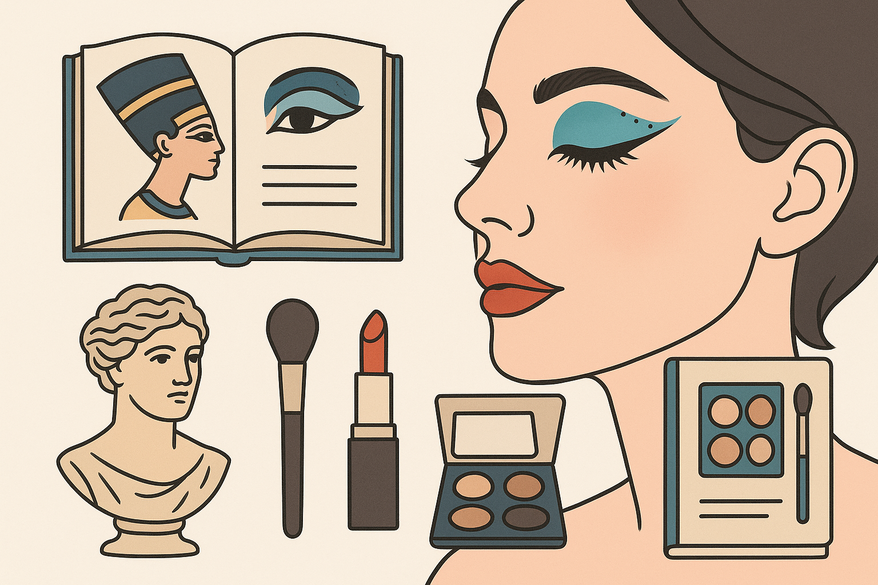
Estimated reading time: 14 minutes
Key Takeaways
- Historical Foundations: From ancient rituals to social-media breakthroughs, makeup has always mirrored cultural shifts.
- Essential Techniques: Master color blending, graphic lining, and textural layering for truly avant-garde looks.
- Modern Tools: Leverage unconventional materials and AI platforms like Makeup Check AI to preview and refine designs.
- Step-by-Step Process: Follow a structured workflow—research, sketch, apply, and document—to bring your vision to life.
- Resources & Community: Tap into tutorials, books, and professional forums to continually expand your skills.
Table of Contents
- 1. The Evolution of Creative Makeup Designs
- 2. Key Elements of Creative Makeup Designs
- 3. Inspiring Trends in Modern Creative Makeup Designs
- 4. Step-by-Step Guide to Creating Your Own Creative Makeup Designs
- 5. Resources and Inspiration for Creative Makeup Designs
- Conclusion & Call to Action
- FAQ
1. The Evolution of Creative Makeup Designs
Understanding the past equips you to innovate today. This section traces cosmetics artistry from ancient rituals to digital-age influences.
1.1 Historical Roots of Creative Makeup Designs
- Ancient Egypt: Kohl-lined eyes denoted status and offered glare protection; bold black around the eyes served ritual and social functions for both genders.
- Victorian Era: Everyday makeup was deemed improper for “respectable” women; theatrical greasepaint remained acceptable only for performers, linking cosmetics with the stage.
References: 4000 Years of Makeup – Evolution
1.2 20th Century Transformations in Creative Makeup Designs
- Early 1900s Mainstreaming: Mass-market lipstick, mascara, and compact powders democratized glamor and reshaped daily routines.
- Roaring ’20s Eye Drama: Film stars flaunted smoky lids and arched brows; innovators like Max Factor and Maybelline introduced specialized mascaras and eye palettes.
References: The Strange & Exciting History of Your Makeup, Evolution of Iconic Eye Looks
1.3 Modern Innovation in Creative Makeup Designs
- 1960s Color & Liner Breakthroughs: Twiggy’s graphic lower lash art and Elizabeth Taylor’s jewel-toned shadows inspired bold color combinations.
- Social Media Era: Instagram and TikTok fuel daily creative experiments—mixing cultural motifs, digital filters, and cutting-edge pigments to push boundaries.
References: Evolution of Iconic Eye Looks, Evolution of Eye Makeup Trends
2. Key Elements of Creative Makeup Designs
This section highlights the tools and techniques that bring non-traditional looks to life.
2.1 Innovative Techniques for Creative Makeup Designs
- Color Blending:
• Seamless gradients—from warm sunset hues to cool jewel tones.
• Painterly effects mimic abstract art; pastel-to-neon transitions add contrast. - Graphic Lining:
• Architectural shapes in gel, pen, or shadow create bold silhouettes around eyes or lips.
• Negative-space cut-creases and floating liner styles add modern edge. - Textural Play:
• Layer glitters, foils, and metallic flakes for three-dimensional depth.
• Adhere crystals, sequins, or appliqués with cosmetic-grade glue.
Reference: Evolution of Eye Makeup Trends
2.2 Materials and Tools for Creative Makeup Designs
- Traditional Tools:
• Eyeshadow palettes (pressed powder, cream, loose pigments)
• Foundations, concealers, setting sprays
• Liners (liquid, gel) and a mix of synthetic/natural-hair brushes - Unconventional Mediums:
• Body paints and alcohol-activated palettes for full-face effects
• Prosthetic adhesives for lightweight 3D shapes
• Organic elements: feathers, dried flowers, pressed petals - Safety Note:
• Always choose skin-safe, dermatologically tested products.
• Verify non-traditional materials carry a cosmetic-grade label.
Many artists now leverage AI-driven platforms like Makeup Check AI to preview and refine designs in real time. These tools offer instant color schemes and product matching without traditional swatching.
3. Inspiring Trends in Modern Creative Makeup Designs
Stay ahead by exploring the looks shaping today’s beauty and fashion scenes.
3.1 Popular Styles of Creative Makeup Designs
- Fantasy & Avant-Garde:
• Mythical creatures: dragon-scale texture with layered glitters.
• Abstract art: asymmetrical color blocks and brushstroke effects. For deeper AI-driven inspiration, see Avant-Garde Makeup Trends. - Festival Looks:
• UV-reactive pigments for neon face painting.
• Rhinestones, gems, and metallic tattoos for high-impact sheen. - Editorial/Runway Artistry:
• Color-blocked eyes that extend beyond lids.
• Exaggerated graphic liners forming cubes or wings.
References: Evolution of Iconic Eye Looks, Evolution of Eye Makeup Trends
3.2 Renowned Makeup Artists & Examples of Creative Makeup Designs
- Pat McGrath: Summptuous textures and high-metallic finishes in luxury editorials; micro-glitters and foil deposits for maximalist impact.
- Isamaya Ffrench: Body-sculpting pigments with splatters and 3D embellishments; raw, experimental beauty in magazines.
- James Molloy: Sculptural color placement with couture flair; exaggerated cheek contours and layered line details.
4. Step-by-Step Guide to Creating Your Own Creative Makeup Designs
Follow these actionable steps to craft standout looks—whether for portfolio shoots or personal experimentation.
4.1 Inspiration & Research
- Gather Visual References:
• Art books, museum catalogs, fashion magazines.
• Digital platforms for nature photography, street style, editorial spreads. - Analyze Professional Work:
• Note color palettes, liner shapes, texture applications.
• Create a mood board (physical or digital) to refine your vision.
4.2 Sketch & Plan
- Face Charts & Digital Mock-Ups:
• Map out color zones, liner routes, embellishment spots.
• Label areas with product types (e.g., “cream shadow,” “fine-tip gel liner”). - Composition Tips:
• Balance symmetry with intentional asymmetry.
• Consider how light and shadow interact with glitter and highlighters.
4.3 Material Preparation
- Standard Essentials:
• Primer, foundation, concealer, setting spray
• Base eyeshadows in transition shades - Specialty Items:
• Body paints, prosthetic adhesives, cosmetic glitters
• Face jewels, micro-pearls, sequins - Patch Testing:
• Swatch new products behind the ear or on the inner arm.
• Wait 24 hours to check for irritation before full-face use.
4.4 Application Process
- Prep Skin: Cleanse, moisturize, then apply primer.
- Outline Design: Sketch shapes and lines with a light pencil or white powder.
- Layer & Blend Colors: Begin with the lightest shade; add depth with darker hues using circular brush motions.
- Define Shapes: Use a fine-tip brush or liner pen for crisp edges and details.
- Add 3D Elements: Secure gems or appliqués with skin-safe adhesive; press gently until bonded.
- Seal the Look: Mist setting spray from 8–10 inches away; let dry without touching the face.
4.5 Tips & Techniques
- Synthetic brushes for creams/liquids; natural-hair for powders.
- Work under daylight-balanced bulbs to see true colors.
- Rest your elbow on a table to minimize hand shake.
- Photograph each stage to review blending and symmetry.
4.6 Safety Considerations
- Patch test every new item; avoid craft glues and non-cosmetic pigments.
- Remove heavy glitter or prosthetics with oil-based removers.
- Follow up with gentle cleanser and a soothing moisturizer.
5. Resources and Inspiration for Creative Makeup Designs
5.1 Tutorials & Platforms
- YouTube Channels:
• NikkieTutorials – HD graphic and editorial demos.
• PONY Syndrome – K-beauty color experiments.
• Jordan Hanz – Avant-garde sculpting and textured artistry. - Must-read Blogs:
Creative Makeup Designs AI
Artistic Makeup Inspiration AI
5.2 Books & Courses
- Making Faces by Kevyn Aucoin: Learn face chart techniques.
- Face Paint: The Story of Makeup by Lisa Eldridge: Historical context and artistry.
- Online masterclasses—search “makeup masterclass” for current celebrity-led workshops.
5.3 Communities
- Reddit r/MakeupAddiction: Peer feedback, product recommendations, before/after posts.
- Professional Forums:
• The Powder Group – Networking for MUA professionals.
• Make Up For Ever Academy’s community—industry news and tips.
Conclusion & Call to Action
Creative makeup designs fuse beauty, fashion, and visual art into compelling statements. By understanding historical origins, mastering cutting-edge techniques, and drawing inspiration from leading artists, you can transform any face into a bold canvas. We want to see your most inventive looks! Leave a comment with questions or share your photos using #creativeMakeupDesigns. Subscribe for more tutorials, trend updates, and insider tips on pushing the boundaries of makeup artistry.
FAQ
- How do I choose the right pigments for avant-garde looks?
Start with high-quality, dermatologically tested products and build swatches on your arm or face chart to test opacity and blendability. - Can I use craft glitters in makeup?
No—always use cosmetic-grade glitters to avoid skin irritation and ensure safe removal. - What’s the best way to photograph my designs?
Use daylight-balanced lighting, a neutral background, and photograph each stage to capture true colors and details. - How can I improve my steady hand for graphic lining?
Rest your elbow on a stable surface, use fine-tip brushes, and work slowly to maintain control.

